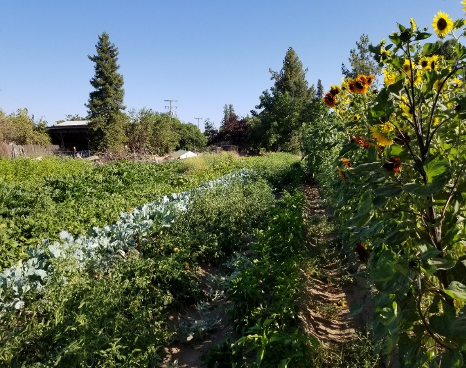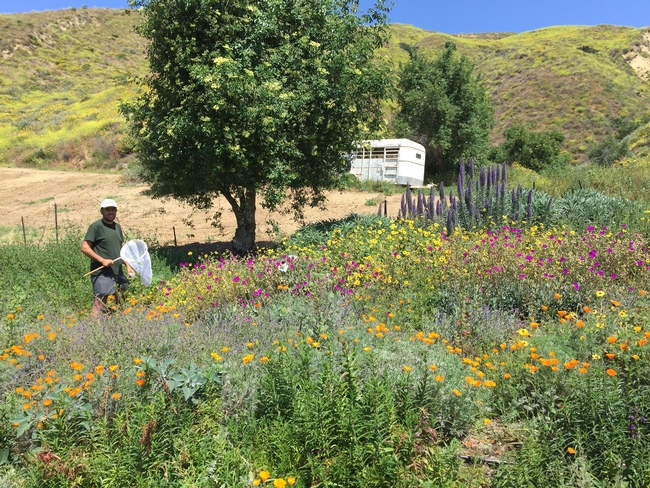- Author: Shulamit Shroder
Steven Lee, PhD, has worked as the farm manager for Quaker Oaks Farm in Visalia, CA for the past 5 years. This 22-acre nonprofit educational center includes 8 acres of native wetlands, 2 acres of organic mixed vegetable crops, and 1 acre of organic stone fruit and Asian pears.
Steven has been working in agriculture for about 20 years, both in the lab and in the field. In 2017, he applied for the first round of Healthy Soils funding to implement a wide variety of conservation practices. The farm already did reduced tillage, but they used HSP funds to offset the costs of buying compost, planting cover crops, spreading mulch, and installing hedgerows.
He started these practices to improve the health of the soil and benefit the local ecosystem.
Practices
For the orchard, Steven has followed the following schedule:
In the spring, he mows down the cover crops and then applies compost. He spreads wood chips on top of the compost. The mulch has not yet caused a nitrogen deficiency in the fruit trees because it stays on top of the soil and is not thoroughly mixed in. In the fall, he disks the mulch in lightly and seeds the cover crops right before a rain. The cover crop mix he planted last year included triticale, vetch, bell beans, and field peas. However, he prefers planting oats over triticale.
In the vegetable cropping area, he follows a different procedure:
He drives up to Williams, CA in the fall to procure organic straw to maintain the farm's organic certification. He then spreads the straw mulch in the area between the vegetable beds. He found that rice straw was too clumpy to spread easily and thus prefers more traditional oat or wheat straw. He then seeds the cover crops into the mulch. The mulch improves cover crop seed germination, as it provides both moisture and protection from hungry birds. After disking in the cover crops in the spring, he plants his vegetable crops.
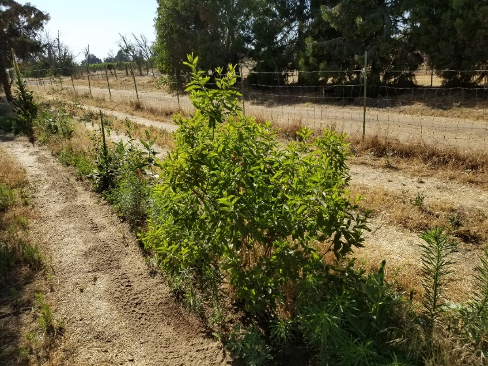
Effects
Soil
In just the past 3 years of doing these practices, the soil organic matter has increased from 1% to 2%. However, the soil pH has also gone up from 7 to 7.5. At some point, the increase in organic matter should help buffer and stabilize the soil.
Yield
The total yield has decreased because of the difficulty of incorporating cover crops into the vegetable system schedule. Cover crops and mulch require more work and effort to implement, and Steven and his team of volunteers couldn't get everything done in time. However, for him, the long-term ecological benefits are more important than a season or two of reduced yields.
Pests
The cover crops and hedgerows have led to increased insect diversity. There are more beneficial insects like ladybugs, green lacewings, assassin bugs, praying mantis, along with more pollinators like bees and hoverflies than there were a couple years ago.
However, there are also more ground squirrels, rabbits, and gophers. There are birds of prey and snakes, but not enough – the cover crops offer cover and protection for these pests.
Erosion
The mulch between the vegetable beds has reduced dust emissions, which makes working in the vegetable beds easier.
Water consumption
In both the trees and the vegetable crops, the mulch and compost keeps the soil moist. Steven has only watered the young fruit trees 3 times this year using furrow irrigation and has not seen any ill effects on tree health.
He has reduced his irrigation frequency on his vegetable crops from every other day to once a week. He estimates that he is now using about half the water he was applying before, but still has plenty of produce.
Overall profitability
Steven doesn't need to buy expensive organic blood meal anymore because the cover crops and compost provide enough nutrition. The long-term stabilization of soil productivity through the implementation of these practices should lead to resilience.
One of the difficulties he's had is that the timing for the Healthy Soils Program doesn't always match up with what makes the most sense for vegetable production. He had to skip a whole cycle to plant cover crops, which ended up costing the farm money.
Recommendations
He would recommend implementing these practices if they fit into your system. If you're interested in trying one of these practices, his advice is to keep it simple.
He is cautious about recommending straw mulch in vegetable crops, because he found it to be time-consuming and not cost effective. The biggest benefit for the straw mulch was that it improved cover crop germination. Spreading wood chips on the orchard floor was easier and so he would recommend that more than he would recommend the straw mulch.
His highest praise was for the hedgerows. He pointed out that you can plant herbs like rosemary, oregano, or sage, which would allow you to both sell a product and promote biodiversity.
Improvements
Looking back over the past 3 years, he would improve his implementation of these practices by simplifying and not overcommitting himself. He had better results when he seeded the cover crops between the vegetable beds instead of on the beds themselves.
He would also like to try further reducing tillage and using a roller crimper. This would turn the terminated cover crops into mulch. That way, he wouldn't need to import mulch from another farm.
He's also interested in doing multiple plantings of cover crops, now that the farm has finished its Healthy Soils project and thus will have more flexibility with its scheduling. For example, planting buckwheat, which grows so fast that it can evade drought and attracts beneficial insects.
- Author: Dana Brady
In Spring 2019, one of the owners from Alves Dairy reached out about applying for an Alternative Manure Management Program (AMMP) grant through CDFA. Only one other project like this in the area exists, so tackling this sort of large-scale manure management project was exciting!
The CDFA AMMP Program provides financial assistance for the implementation of manure management practices in California, which will result in reduced greenhouse gas emissions. This grant program is open to all livestock operations, although dairies are the most common applicants. A total of 58 projects have been funded since the grant program started in 2017, resulting in 716,800 metric tons of carbon dioxide equivalents reduced in 5 years. These projects can fall under four general categories, pasture-based management, solid separation, alternative manure treatment and storage, and conversion from flush to scrape.
The Alves Family started their Dairy in the 1920's and have sustained their operation in the county ever since. The four brothers, Greg, Rich, Gary and Mike, and the next generation, Chris and Scott, share responsibilities for the operation, where they have game birds, corn, alfalfa, orchards and their dairy, with each partner taking on a role to make the whole farm run smoothly. The family is very involved in the community and support local projects and organizations as well.
The Alves originally came to UCCE with this idea because they wanted to improve manure management practices on the dairy and reduce their overall methane emissions. Greg, one of the brothers and owners, spent a large part of his time cleaning manure from the lagoons, taking time away from other important projects on the dairy. With this in mind, we constructed a plan to hopefully make his life, and others on the dairy, a lot easier and achieve significant environmental benefits.
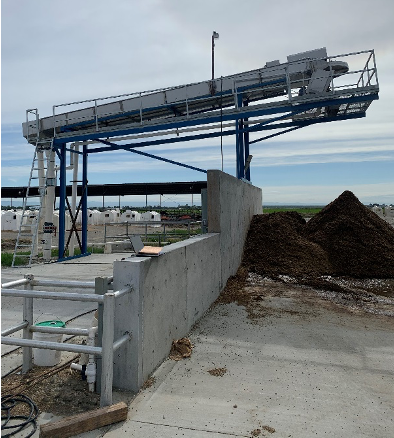
The Alves applied under the solid separation category to install a manure separator, a concrete slab and walls, and a new pump that would replace an old diesel pump. The separator filtered out the manure solids, resulting in nutrient rich solid manure to be spread onto fields and reduce the amount of time the solids spend in anaerobic lagoons, creating methane gases. This project will also reduce a substantial amount of greenhouse gases due to not needing to use the excavator to move manure around, or as many truck loads to export the material.
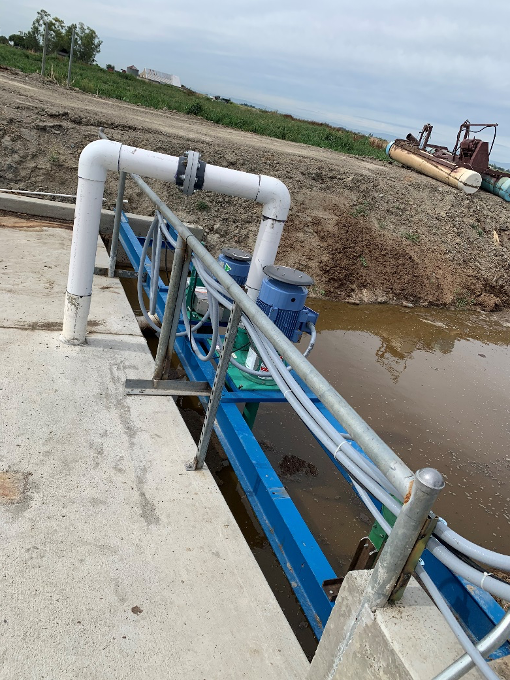
On January 1, 2020, the project started and the Alves hit the ground running. All of the partners contributed their own time and energy to this project to make it such a success. Over the past six months, the Alves completely finished their project a year ahead of schedule, and have just recently completed their final verification with CDFA. The verification was done remotely this year and consisted of a Zoom call with Greg to answer some questions, talk about his experience and show off his finished project.
Greg has already seen the both environmental and personal benefits from the separator project and hopes to continue making the dairy more sustainable in the future.
- Author: Shulamit Shroder
Congrats! You've been awarded a grant from the California Department of Food and Agriculture's Healthy Soils Program. Now what?
Once your grant has been executed and before you implement any of your practices, you need to take soil samples to measure the soil's baseline organic matter content. You will need to take soil samples 3 times over the course of your project. You should take the soil samples at the same time of the year every year. You should not take soil samples right after major rain events or right after you've applied soil amendments like manure.
How do you take soil samples? Here's the CDFA's protocol:
First of all, here's what you need to bring to the field:
- Plastic buckets
- Soil sample bags or one-gallon freezer storage bags (one bag per sample)
- Clipboard and papers for recording
- Permanent marker
- Straight shovel or soil probe
Where should you take your samples?
You should check your grant agreement to see how many soil samples you said you would take. Usually, it's 1 sample per APN or per field.
Next, mark an area of 30' by 30'. Take samples from 9-10 locations within that sampling unit. You can pick your locations by either:
- Walking in a zig-zag pattern
- Dividing the field into 9 grids of 10' by 10' and collecting one sample from each grid
Once you've chosen a location, here's how you can take a sample:
- Remove any vegetation, litter, or crop residue
- If you use a shovel:
- Use the shovel to dig a small hole 8” deep. From the side of the hole, take a vertical rectangular slice of soil 8” deep and 2” thick. Remove any extra soil to ensure that the sample is the same width at the top and bottom of the slice.
- If you use a soil probe:
- Twist the probe into the ground until the probe is 8” deep.
- Place sample into clean bucket
- Go to the next location and repeat until you finish all 9-10 sampling locations.
- Mix soils in the bucket and pour at least 6 cups/1 lb of soil into the sample bag.
- Label the sample bag with the APN, sampling date, and farm name.
Now that you have your sample, send it to a soil lab nearby that uses UC methods. Tell the lab that you'll need results for the soil's organic matter content.
For more information, reach out to your local climate smart agriculture specialist. We can help you take your soil samples and find a local soil lab. For more information, read through the grant manual: https://www.cdfa.ca.gov/oefi/healthysoils/docs/2020-HSPIncentives-GAPManual.pdf
- Author: Shulamit Shroder
Grower Profile #1: Frank Fernandes
Practices: No-Till, Strip-Till, and Cover Crops
Frank Fernandes grew up in a big dairy family in Tulare County. He has continued that tradition and now farms about 1,500 acres near Pixley. He grows corn, wheat, and alfalfa as forage for his cows. He also has a young pistachio orchard.
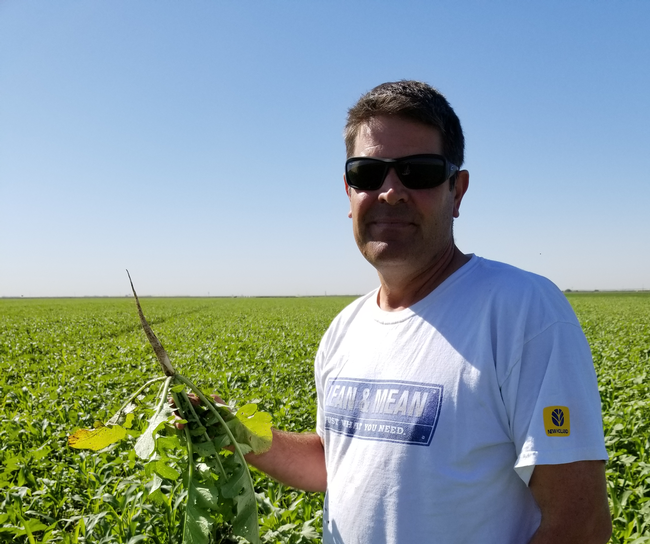
Transition
Frank and his brothers were among the first in their area to try out no-till 20 years ago. They ran into difficulties and converted to strip tillage 18 years ago. This practice minimizes the number of tillage passes they do. On his strip-till fields, Frank has gone from doing 15 passes per year to only 4 or 5, which saves him fuel and time. He currently implements a hybrid system of strip-till wheat and no-till corn. In 2020, he received a grant award from the California Department of Food and Agriculture's Healthy Soils Program to expand his use of strip tillage.
What initially drove Frank and his brothers to implement strip tillage on their fields was the prospect of reducing their tillage and fertilizer costs. When Frank started going to conferences and meetings about soil health, he learned about the soil health benefits of reducing disturbance and increasing plant diversity.
Four years ago, those discussions inspired him to test out a no-till system on one of his fields and to experiment with cover crops. In this field, he's down to 3 passes per year and 2 crops. He will have to stop planting cover crops in his forage fields to comply with his groundwater agency's implementation of the Sustainable Groundwater Management Act. However, he will continue to plant cover crops in his pistachio orchard, as he believes that the benefits of cover crops there outweigh the extra water costs.
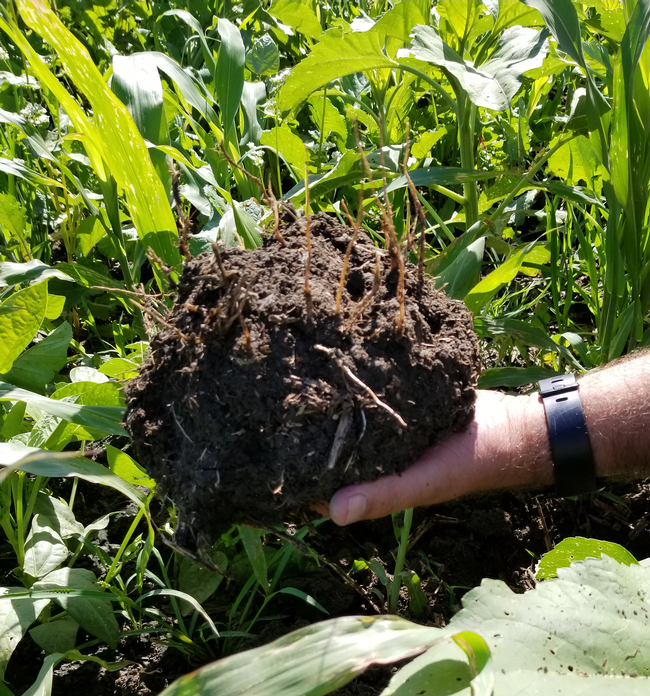
Benefits
Frank has found many benefits in implementing no-till and cover crops on his trial field.
Economics
The first major benefit is his reduction in costs. He has seen a decrease in fuel costs due to fewer tractor passes. He has also begun to reduce his fertilizer usage, since his cover crops provided some of the nutrients needed for his forage crops.
These practices did come with a negative effect on yield for the first couple years of his trial, but he found that the decrease in costs outweighed the drop in yield. The practices still penciled out, even in that first year. The yields have steadily increased over the past 4 years, while the costs have remained low.
Pests
Cover crops are supposed to encourage the proliferation of beneficial insects that reduce pest pressure. Frank has had very little pest pressure this year and has only had to spray insecticide once, but this might be due to this year's weather. He explained that it's hard to see the effects of a cover crop in one field when he's surrounded by growers spraying much more than he does, inadvertently killing off the very beneficial insects he wants to encourage.
Water
In terms of water consumption, he has seen that his no-till field needs more water to get to saturation when he irrigates. However, the field can go for longer periods of time between irrigation events and needs fewer overall irrigation events. He's also seen that the crops suffer less from heat and drought stress than those in neighboring fields. The soil itself is cooler and keeps the plants healthier.
Weeds
He's seen fewer weeds in his no-till field, which has resulted in 1 fewer herbicide application per year compared to his other fields. Weed seeds deep in the soil profile remain buried and cannot germinate. However, he pointed out that cover crops themselves can become weeds, so it is very important to pick the right cover crop for your situation.
Other
One of the intangible benefits that Frank mentioned is that doing these practices has made farming more fun and enabled him to feel good about his stewardship of his land. He feels like he is doing his part to farm in a more sustainable way.
Difficulties
Cover crops
Frank has faced 2 main challenges with his cover crops.
The first is planting the seed correctly. The drill doesn't always put the seed into the soil at the right depth, so the field doesn't get a uniform seed coverage.
The other challenge is, of course, water. He has the choice to irrigate his cover crops and pay for that extra water or depend on the unpredictable winter rains.
No-till
The biggest challenge that Frank has faced with implementing no-till on his field is psychological. Not disking or ripping the field goes against decades of experience. Doing this method was a big leap of faith at the beginning of this trial, when he wasn't yet seeing the benefits. But now, he says that only doing 3 passes per year is no longer a difficulty. It's a major advantage in terms of reduced costs.
Recommendations
Frank would cautiously recommend these practices to other farmers. He explained that not all irrigation systems are set up for the challenges and each farm is different, so each grower's learning curve will be different.
For those starting out, he recommends starting small and slow. That way, the impact of that learning curve on your bottom line will be minimal. Growers can expect to start saving money that first year, despite the lower yields while the soil adapts to the change in management.
Cover crops
For cover crops, Frank recommends planting later in the season when there is more moisture. For instance, planting right before a big storm so that the cover crops can take advantage of the rain.
Strip till
He also found that it's best to work the ground for strip tillage right behind the chopping crew. This leaves the ground moist and produces a nice seed bed. If you wait, you run the risk of the ground getting too hard and breaking your equipment.
Equipment
He has ended up simplifying his equipment needs. He went from a disk to a vertical tillage bar. Instead of buying more and more equipment, he decided to sell off the intensive tillage equipment that he no longer used and use the proceeds to buy the equipment that would enable him to do no-till and strip till.
- Author: Alli Fish
Hedgerows are an approved practice under California Department of Agriculture's Healthy Soils Grant Program. That means, growers are eligible to receive grant funding for planting hedgerows. But what exactly are the benefits of hedgerows and why are they worth planting? As a perennial planting it can have immediate impacts on the soil, but what else? The answer lies large in the pollinators and beneficial insects they attract.
The most basic definition of a hedgerow is dense vegetation planted in a linear design. Perennial grasses, shrubs, and even short trees are all candidates for hedgerow plantings, provided they meet the conditions of the local climate and soil. Growers plant hedgerows to achieve one or more of the following desired outcomes:
- To increase habitat for pollinator and beneficial insect populations
- To create a living barrier or fence
- To reduce chemical drift or odor movement
- To intercept airborne particulate matter
- To act as a low windbreak or reduce dust
- To increase carbon storage in biomass and soils
- To provide food, shelter, and shade for aquatic organisms in nearby aquatic habitats
All of these benefits make the case for planting hedgerows on any agricultural operation. In Ventura County, avocado growers stand to see a compelling case for hedgerow plantings with particular attention to pollination services.
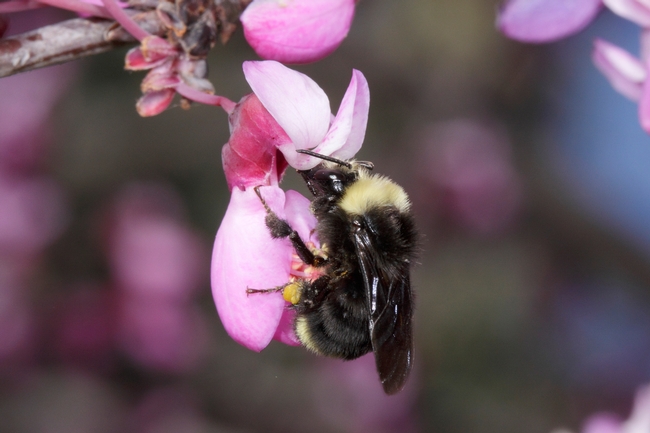
There are many different pollinators who visit avocado flowers, from native bees to flies to honey bees. Some come in the daytime, others visit at night. In the likelihood that honey bees and other pollinators will continue to decline, it is imperative to study the importance of native pollinators on key crops and identify ways to increase habitat for resident populations (NRC 2007; Nordhaus 2011; PHTF 2015; Koh et al. 2016; Sánchez-Bayo and Wyckhuys 2019; DiBartolomeis et al. 2019; Garibaldi et al. 2013). This information not only helps the pollinator populations thrive, but helps avocado growers acquire free increased pollination services for fruitful trees. Several researchers have published accounts of increased pollinator diversity and numbers in hedgerow and field edge planting studies across various agricultural systems (Heller et al. 2019; Long and Anderson 2010; Long et al. 2017; Williams et al. 2015).
In Ventura County, we are seeing some fascinating and relevant research around the impact of hedgerows on pollinators in avocado orchards. A collaborative research project involving Dr. Ben Faber, Avocado Advisor for UC Cooperative Extension Ventura County, and Dr. Gordon Frankie, professor and research entomologist at UC Berkeley and lead investigator of the UC Berkeley Urban Bee Lab, seeks to understand long-term impacts of hedgerows on pollinators of avocado trees. The project, which began in 2014 with three participating avocado ranches, has indicated increased pollinator activity, increased native bee populations, and increased diversity of species with the presence of hedgerow plantings (Frankie, Faber et al. 2020). The results indicate the importance of diversity of pollinator species, not just the honeybee, to avocados. In continuing this research, the team seeks to address the unanswered questions of which pollinators are the most effective at pollinating avocados and which are the most effective at influencing fruit set. A particularly exciting and novel aspect of this project is looking at whether or not there are nocturnal pollinators visiting California avocados. Nocturnal pollinators have been well documented in New Zealand (Pattemore et al, 2018), but none have been yet recorded in California avocados.
Maintaining hedgerows is critical to providing additional habitat for an abundance of pollinators. Creating and maintaining that hedgerow and for which pollinators can be a daunting task to embark on. Luckily for avocado growers, Dr. Frankie and Dr. Faber's team are working with Southern California growers to develop a pollinator garden manual. The manual will provide clear pictures of key pollinators and key plant species that pollinators are drawn to. Detailed imagery, descriptions, and maintenance tips will help make the decision making around planting a hedgerow much easier.
Speaking of selections, there are key plants that are drought-tolerant, easy to maintain, and well-suited for Ventura County's climate. See the table below for some ideas.
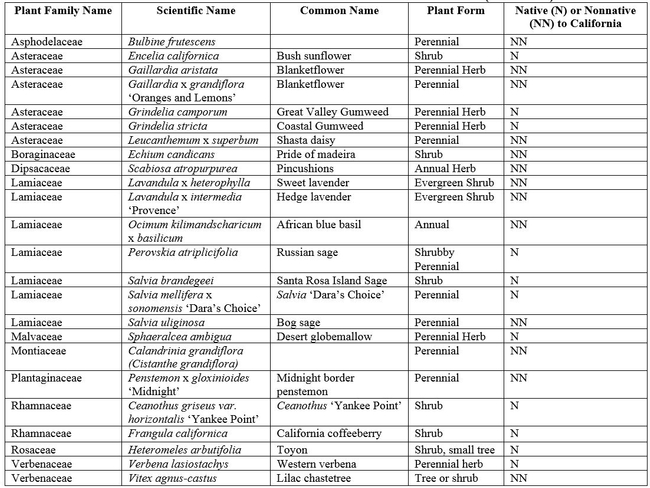
We seek to increase biodiversity, build soil health, and reduce energy use in our agricultural systems to improve our resiliency to climate change impacts, pests, and disease. To keep farming in our families and in our futures. Planting hedgerows is good for the pollinators, which is good for the bottom line and long-term success of the operation.
If you are an avocado grower interested in learning more about the pollinator research project, please contact Dr. Gordon Frankie at the UC Berkeley Urban Bee Lab gwfrankie@berkeley.edu.
Interested in planting hedgerows on your property? You may be able to qualify for a grant through CDFA's Healthy Soils Grant Program to plant hedgerows. Please contact Jamie Whiteford with the Ventura County Resource Conservation District at jamiewhiteford.vcrcd@gmail.com for more information on how to apply. For those in other areas, Technical Assistance providers are able to discuss the values of hedgerows and funding opportunities for installing them in other agricultural situations: http://ciwr.ucanr.edu/Programs/ClimateSmartAg/TechnicalAssistanceProviders/
References Cited
DiBartolomeis, M., S. Kegley, P. Mineau, R. Radford, and K. Klein. 2019. An assessment of acute insecticide toxicity loading (AITL) of chemical pesticides used on agricultural land in the United States. PLoS ONE 14(8): e0220029. https://doi.org/10.1371/journal.pone.0220029.
Frankie, G., B. Faber, J. Pawelek, R. Thorp, R. Coville, C. Jadallah, E. Takele, S. I. Rios, T. Bean. 2020. Native Pollinators of California Avocado as Affected by Introduced Pollinator Gardens. International Society of Horticultural Sciences Congress. Acta Horticulturae.
Garibaldi, L.A., I. Steffan-Dewenter, R. Winfree, and 47 other authors. 2013. Wild pollinators enhance fruit set of crops regardless of honey bee abundance. Science 339:1608-1611.
Heller, S., N. K. Joshi, T. Leslie, E. G. Rajotte and D. J. Biddinger. 2019. Diversified Floral Resource Plantings Support Bee Communities after Apple Bloom in Commercial Orchards. Scientific Reports 9 Article number: 17232.
Koh, I., Lonsdorf, E. V., Williams, N. M., Brittain, C., Isaacs, R., Gibbs, J., Ricketts, T. H. 2016. Modeling the status, trends, and impacts of wild bee abundance in the United States. Proceedings of the National Academy of Sciences 113:140–145.
Long, R. F. and J. Anderson. 2010. Establishing Hedgerows on Farms in California. UC ANR Pub 8390, Oakland, CA. http://anrcatalog.ucanr.edu/Details.aspx?itemNo=8390
Long, R., K. Garbach and L. Morandin. 2017. Hedgerow benefits align with food production and sustainability goals. California Agriculture 71:117-119. 10.3733/ca.2017a0020.
NRC. 2007. Status of Pollinators in North America. National Research Council of the National Academies. National Academies Press, Washington, D.C.. 307 p.
Nordhaus, H. 2011. The Beekeeper's Lament. Harper Perennial, NY. 269p.
Pattemore, D., M. N. Buxton, B. T. Cutting, H. McBrydie, M. Goodwin, A. Dag. 2018. Low overnight temperatures associated with a delay in ‘Hass' avocado (Persea americana) female flower opening leading to nocturnal flowering. Journal of Pollination Ecology 23(14): 127-135.
PHTF: Pollinator Health Task Force. 2015. Pollinator Research Action Plan. The White House.
Sánchez-Bayo, F. and K. A. G. Wyckhuys. 2019. Worldwide decline of the entomofauna: A review of its drivers. Biological Conservation 232:8-27.
Williams, N. M., K. L. Ward, N. Pope, R. Isaacs, J. Wilson, E. A. May, J. Ellis, J. Daniels, A. Pence, K. Ullmann, and J. Peters. 2015. Native wildflower plantings support wild bee abundance and diversity in agricultural landscapes across the United States. Ecological Applications 25: 2119–2131

